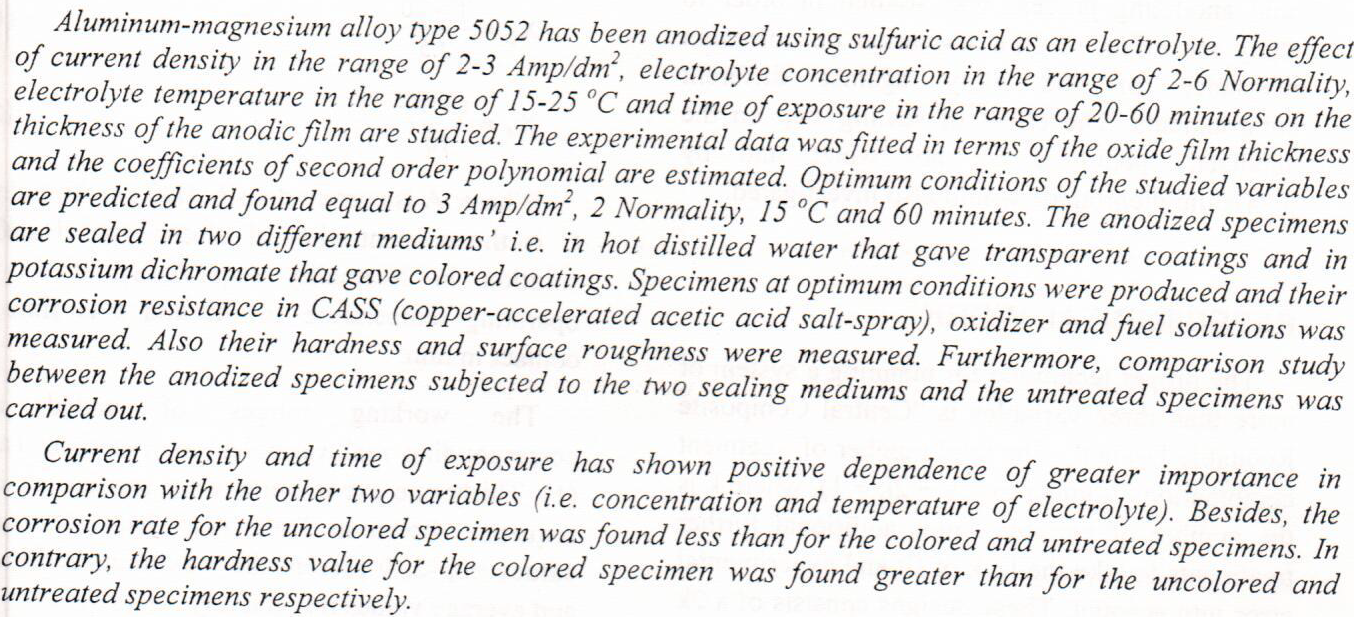
Background: The surface properties of the titanium alloy plays a significant role in the bond of the dental implant with living bone and modification of the implant surface could enhance osseointegration. This study was aimed to investigate the effect of different durations of heat treatment on the surface properties of titanium alloy for dental implants. Materials and methods: Twenty disks of (Ti-6Al-4V) alloy were prepared. The sample was divided into four test groups to study the effect of different duration of heat treatment to the surface topography; surface chemistry, titanium oxide layer thickness, blood contact angle, & blood drop diameter of titanium alloy samples were investigated to evaluate the effect of different durations of
... Show MoreTwo experiments were carried out, the first at the College of Agriculture - University of Baghdad during spring season 2017 Everest cv. class (Elite) was used to study the effect of foliar application of calcium and magnesium and addition of humic acid to the soil on potato growth and yield, The layout of the experiment was factorial within RCBD design using three replicates. Calcium and Magnesium sprayed with concentrations (0, 500, 1000 mg.L-1), while the humic acid was added to the soil with (0, 0.75 gm.m2), The second experiment included storage of tubers produced from the spring season, with to study the effect of field treatments on improving the storability of the tubers. The results showed that the treatment of calci
... Show More (10)
(10)
 (1)
(1)
Friction stir spot welding (FSSW) is a relatively new welding process that may have significant advantages compared to the fusion processes as follows joining of conventionally non-fusion weldable alloys, reduced distortion and improved mechanical properties of weldable alloys joints due to the pure solidstate joining of metals. In this paper, a three-dimensional model based on finite element analysis is used to study the thermal history in the spot-welding of aluminum alloy 2024. The model take place the thermomechanical property on the process of the welded metals. The thermal history and the evolution results with numerical model at the measured point in the friction stirred spot weld have a good matching, then the prediction of the t
... Show MoreThis paper introduces an experimental study on the behavior of confined concrete filled aluminum tubular (CFT) column to improve strength design, ductility and durability of concrete composite structures under concentrically loaded in compression to failure. To achieve this: seven column specimens with same concrete diameter 100mm and without steel reinforcement have been examined through experimental testing, which are used to study the effects of the thickness of the aluminum tube encased concrete ( thickness : 0mm, 2mm, 3mm, 4mm and 5mm with same length of column 450mm), length of column (thickness 5mm and length of column 700mm) and durability (thickness 5mm and length of column 450mm) on the structural behavior of &
... Show MoreOne of the most essential components of asphalt pavements is the filler. It serves two purposes. First, this fine-grained material (diameter less than 0.075 mm) improves the cohesiveness of aggregate with bitumen. Second, produce a dense mixture by filling the voids between the particles. Aluminum dross (AD), which is a by-product of aluminum re-melting, is formed all over the world. This material causes damage to humans and the environment; stockpiling AD in landfills is not the best solution. This research studies the possibility of replacing part of the conventional filler with aluminum dross. Three percent of dross was used, 10, 20, and 30% by filler weight. The MarshallMix design method was adopted to obtain the op
... Show More (1)
(1)
 (36)
(36)
 (23)
(23)
The driving idea for the present work was to combine the effect of polyvinyl alcohol (PVA) as corrosion inhibitor with the distance between the anodic and cathodic elements of the galvanic cell, beside their area ratio, in scope of synergistic suppression of galvanic corrosion on Cu/Fe model couple, using weight loss method. The performance affecting galvanic corrosion process has been tested for three major factors affect the process:
1. Four PVA inhibitor concentrations were selected to be (0, 1000, 4000 and 7000 ppm) in simulated cooling water.
2. Two cathode: anode area ratios as 1:1 and 2.4:1.
3. Two distances apart cathode – anode as 3 and 7 cm.
Maximum corrosion inhibition achieved was 86% which indicates that increa
An effort is made to study the effect of composite nanocoating using aluminum-9%wt silicon alloys reinforced with different percentage (0.5,1,2,4)wt.% of carbon nanotubes (CNTs) using plasma spraying. The effect of this composite on corrosion behavior for AA6061-T6 by extrapolation Tafel test in sea water 3.5wt% NaCl was invested. Many specimens where prepared from AA6061-T6 by the dimension (15x15x3)mm as this first set up and other steps include coating process, X-ray diffraction and SEM examination .The results show the CNTs increase the corrosion rate of the nanocomposite coatings with increasing the weight percentage of CNTs within the Al-Si matrix. Al-9wt%Si coating layer itself has less corrosion rate if compared with both n
... Show More (2)
(2)
 (9)
(9)
 (9)
(9)
Metal oxide nanoparticles demonstrate uniqueness in various technical applications due to their suitable physiochemical properties. In particular, yttrium oxide nanoparticle(Y2O3NPs) is familiar for technical applications because of its higher dielectric constant and thermal stability. It is widely used as a host material for a variety of rare-earth dopants, biological imaging, and photodynamic therapies. In this investigation, yttrium oxide nanoparticles (Y2O3NPs) was used as an ecofriendly corrosion inhibitor through the use of scanning electron microscopy (SEM), Fourier transforms infrared spectroscopy (FT-IR), UV-Visible spectroscopy, X-ray diffraction (XRD), and energy dispersive X-ray spe
... Show More (3)
(3)
 (2)
(2)
